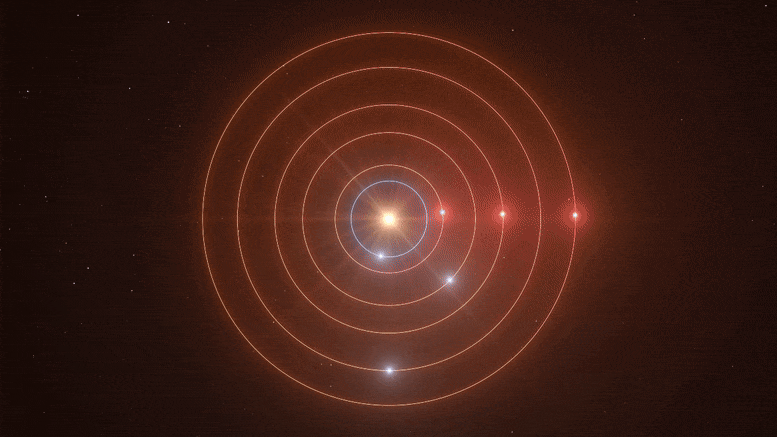
Astronomers have discovered a system with six exoplanets, where five are in a rare synchronized orbit around their central star.
Using a combination of telescopes, including the Very Large Telescope of the European Southern Observatory (ESO’s VLT), astronomers have revealed a system consisting of six exoplanets, five of which are locked in a rare rhythm around their central star. The researchers believe the system could provide important clues about how planets, including those in the Solar System, form and evolve.
The first time the team observed TOI-178, a star some 200 light-years away in the constellation of Sculptor, they thought they had spotted two planets going around it in the same orbit. However, a closer look revealed something entirely different. “Through further observations we realized that there were not two planets orbiting the star at roughly the same distance from it, but rather multiple planets in a very special configuration,” says Adrien Leleu from the Université de Genève and the University of Bern, Switzerland, who led a new study of the system published today (January 25, 2021) in Astronomy & Astrophysics.
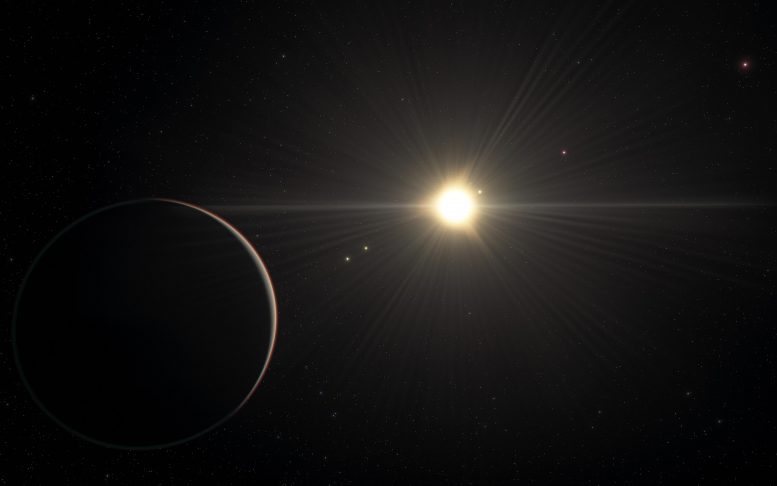
This artist’s impression shows the view from the planet in the TOI-178 system found orbiting furthest from the star. New research by Adrien Leleu and his colleagues with several telescopes, including ESO’s Very Large Telescope, has revealed that the system boasts six exoplanets and that all but the one closest to the star are locked in a rare rhythm as they move in their orbits. But while the orbital motion in this system is in harmony, the physical properties of the planets are more disorderly, with significant variations in density from planet to planet. This contrast challenges astronomers’ understanding of how planets form and evolve. This artist’s impression is based on the known physical parameters for the planets and the star seen, and uses a vast database of objects in the Universe. Credit: ESO/L. Calçada/spaceengine.org
The new research has revealed that the system boasts six exoplanets and that all but the one closest to the star are locked in a rhythmic dance as they move in their orbits. In other words, they are in resonance. This means that there are patterns that repeat themselves as the planets go around the star, with some planets aligning every few orbits. A similar resonance is observed in the orbits of three of Jupiter’s moons: Io, Europa and Ganymede. Io, the closest of the three to Jupiter, completes four full orbits around Jupiter for every orbit that Ganymede, the furthest away, makes, and two full orbits for every orbit Europa makes.
Using a combination of telescopes, including the Very Large Telescope of the European Southern Observatory (ESO’s VLT), astronomers have revealed a system consisting of six exoplanets, five of which are locked in a rare rhythm around their central star. This video summarizes the discoveries and explains why this puzzling system is challenging our theories of how planets form. Credit: ESO
The five outer exoplanets of the TOI-178 system follow a much more complex chain of resonance, one of the longest yet discovered in a system of planets. While the three Jupiter moons are in a 4:2:1 resonance, the five outer planets in the TOI-178 system follow a 18:9:6:4:3 chain: while the second planet from the star (the first in the resonance chain) completes 18 orbits, the third planet from the star (second in the chain) completes 9 orbits, and so on. In fact, the scientists initially only found five planets in the system, but by following this resonant rhythm they calculated where in its orbit an additional planet would be when they next had a window to observe the system.
More than just an orbital curiosity, this dance of resonant planets provides clues about the system’s past. “The orbits in this system are very well ordered, which tells us that this system has evolved quite gently since its birth,” explains co-author Yann Alibert from the University of Bern. If the system had been significantly disturbed earlier in its life, for example by a giant impact, this fragile configuration of orbits would not have survived.
This animation shows a representation of the orbits and movements of the planets in the TOI-178 system. New research by Adrien Leleu and his colleagues with several telescopes, including ESO’s Very Large Telescope, has revealed that the system boasts six exoplanets and that all but the one closest to the star are locked in a rare rhythm as they move in their orbits (represented in orange). In other words, they are in resonance. This means that there are patterns that repeat themselves rhythmically as the planets go around the star, with some planets aligning every few orbits.
In this artist’s animation, the rhythmic movement of the planets around the central star is represented through a musical harmony, created by attributing a note (in the pentatonic scale) to each of the planets in the resonance chain. This note plays when a planet completes either one full orbit or one half orbit; when planets align at these points in their orbits, they ring in resonance.
Credit: ESO/L. Calçada
Disorder in the rhythmic system
But even if the arrangement of the orbits is neat and well-ordered, the densities of the planets “are much more disorderly,” says Nathan Hara from the Université de Genève, Switzerland, who was also involved in the study. “It appears there is a planet as dense as the Earth right next to a very fluffy planet with half the density of Neptune, followed by a planet with the density of Neptune. It is not what we are used to.” In our Solar System, for example, the planets are neatly arranged, with the rocky, denser planets closer to the central star and the fluffy, low-density gas planets farther out.
“This contrast between the rhythmic harmony of the orbital motion and the disorderly densities certainly challenges our understanding of the formation and evolution of planetary systems,” says Leleu.
This artist’s animation shows the view from the planet in the TOI-178 system found orbiting furthest from the star, with the inner planets visible in the background. New research by Adrien Leleu and his colleagues with several telescopes, including ESO’s Very Large Telescope, has revealed that the system boasts six exoplanets and that all but the one closest to the star are locked in a rare rhythm as they move in their orbits.
This animation is based on the known physical parameters for the planets and the star seen, and uses a vast database of objects in the Universe.
Credit: ESO/L. Calçada/spaceengine.org
Combining techniques
To investigate the system’s unusual architecture, the team used data from the European Space Agency’s CHEOPS satellite, alongside the ground-based ESPRESSO instrument on ESO’s VLT and the NGTS and SPECULOOS, both sited at ESO’s Paranal Observatory in Chile. Since exoplanets are extremely tricky to spot directly with telescopes, astronomers must instead rely on other techniques to detect them. The main methods used are imaging transits — observing the light emitted by the central star, which dims as an exoplanet passes in front of it when observed from the Earth — and radial velocities — observing the star’s light spectrum for small signs of wobbles which happen as the exoplanets move in their orbits. The team used both methods to observe the system: CHEOPS, NGTS and SPECULOOS for transits and ESPRESSO for radial velocities.
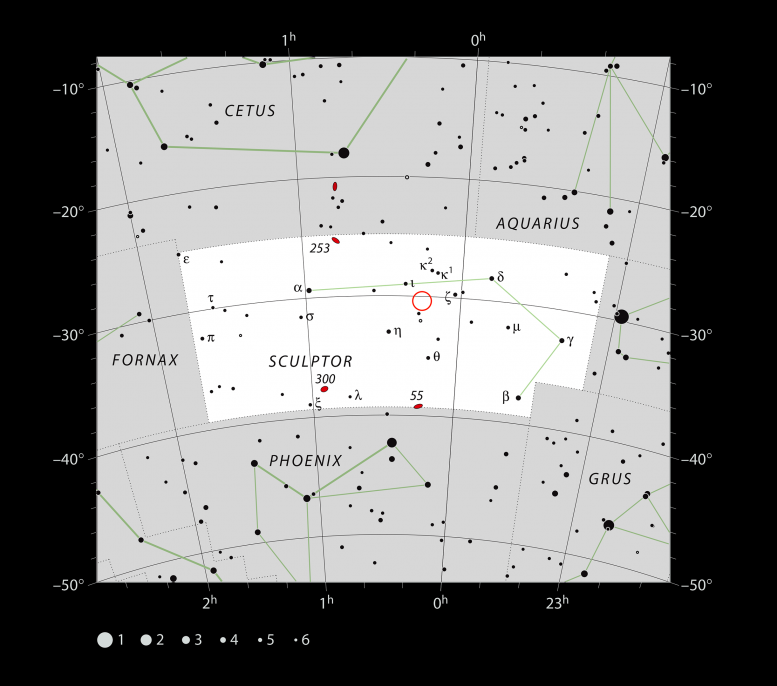
This chart shows the location of the planetary system TOI-178 in the constellation of Sculptor. The map includes most of the stars visible to the unaided eye under good conditions, and the location of the system is indicated by a red circle. Credit: ESO, IAU and Sky & Telescope
By combining the two techniques, astronomers were able to gather key information about the system and its planets, which orbit their central star much closer and much faster than the Earth orbits the Sun. The fastest (the innermost planet) completes an orbit in just a couple of days, while the slowest takes about ten times longer. The six planets have sizes ranging from about one to about three times the size of Earth, while their masses are 1.5 to 30 times the mass of Earth. Some of the planets are rocky, but larger than Earth — these planets are known as Super-Earths. Others are gas planets, like the outer planets in our Solar System, but they are much smaller — these are nicknamed Mini-Neptunes.
Although none of the six exoplanets found lies in the star’s habitable zone, the researchers suggest that, by continuing the resonance chain, they might find additional planets that could exist in or very close to this zone. ESO’s Extremely Large Telescope (ELT), which is set to begin operating this decade, will be able to directly image rocky exoplanets in a star’s habitable zone and even characterize their atmospheres, presenting an opportunity to get to know systems like TOI-178 in even greater detail.
Reference: “Six transiting planets and a chain of Laplace resonances in TOI-178” by A. Leleu, Y. Alibert, N. C. Hara, M. J. Hooton, T. G. Wilson, P. Robutel, J.-B. Delisle, J. Laskar, S. Hoyer, C. Lovis, E. M. Bryant, E. Ducrot, J. Cabrera, J. Acton, V. Adibekyan, R. Allart, C. Allende Prieto, R. Alonso, D. Alves, D. R. Anderson et al., 25 January 2021, Astronomy & Astrophysics.
DOI: 10.1051/0004-6361/202039767
The team is composed of A. Leleu (Observatoire Astronomique de l’Université de Genève, Switzerland [UNIGE], University of Bern, Switzerland [Bern]), Y. Alibert (Bern), N. C. Hara (UNIGE), M. J. Hooton (Bern), T. G. Wilson (Centre for Exoplanet Science, SUPA School of Physics and Astronomy, University of St Andrews, UK [St Andrews]), P. Robutel (IMCCE, UMR8028 CNRS, Observatoire de Paris, France [IMCCE]), J.-B Delisle (UNIGE), J. Laskar (IMCCE), S. Hoyer (Aix Marseille Univ, CNRS, CNES, LAM, France [AMU]), C. Lovis (UNIGE), E. M. Bryant (Department of Physics, University of Warwick, UK [Warwick], Centre for Exoplanets and Habitability, University of Warwick [CEH]), E. Ducrot (Astrobiology Research Unit, Université de Liège, Belgium [Liège]), J. Cabrera (Institute of Planetary Research, German Aerospace Center (DLR), Berlin, Germany [Institute of Planetary Research, DLR]), J. Acton (School of Physics and Astronomy, University of Leicester, UK [Leicester]), V. Adibekyan (Instituto de Astrofísica e Ciências do Espaço, Universidade do Porto, Portugal [IA], Centro de Astrofísica da Universidade do Porto, Departamento de Física e Astronomia, Universidade do Porto [CAUP]), R. Allart (UNIGE), C, Allende Prieto (Instituto de Astrofísica de Canarias, Tenerife [IAC], Departamento de Astrofísica, Universidad de La Laguna, Tenerife [ULL]), R. Alonso (IAC, ULL), D. Alves (Camino El Observatorio 1515, Las Condes, Santiago, Chile), D. R Anderson (Warwick, CEH), D. Angerhausen (ETH Zürich, Institute for Particle Physics and Astrophysics), G. Anglada Escudé (Institut de Ciències de l’Espai [ICE, CSIC], Bellaterra, Spain, Institut d’Estudis Espacials de Catalunya [IEEC], Barcelona, Spain), J. Asquier (ESTEC, ESA, Noordwijk, the Netherlands [ESTEC]), D. Barrado (Depto. de Astrofísica, Centro de Astrobiologia [CSIC-INTA], Madrid, Spain), S.C.C Barros (IA, Departamento de Física e Astronomia, Universidade do Porto), W. Baumjohann (Space Research Institute, Austrian Academy of Sciences, Austria), D. Bayliss (Warwick, CEH), M. Beck (UNIGE), T. Beck (Bern) A. Bekkelien (UNIGE), W. Benz (Bern, Center for Space and Habitability, Bern, Switzerland [CSH]), N. Billot (UNIGE), A. Bonfanti (IWF), X. Bonfils (Université Grenoble Alpes, CNRS, IPAG, Grenoble, France), F. Bouchy (UNIGE), V. Bourrier (UNIGE), G. Boué (IMCCE), A. Brandeker (Department of Astronomy, Stockholm University, Sweden), C. Broeg (Bern), M. Buder (Institute of Optical Sensor Systems, German Aerospace Center (DLR) [Institute of Optical Sensor Systems, DLR]), A. Burdanov (Liège, Department of Earth, Atmospheric and Planetary Science, Massachusetts Institute of Technology, USA), M. R. Burleigh (Leicester), T. Bárczy (Admatis, Miskok, Hungary), A. C. Cameron (St Andrews), S. Chamberlain (Leicester), S. Charnoz (Université de Paris, Institut de physique du globe de Paris, CNRS, France), B. F. Cooke (Warwick, CEH), C. Corral Van Damme (ESTEC), A. C. M. Correia (CFisUC, Department of Physics, University of Coimbra, Portugal, IMCCE, UMR8028 CNRS, Observatoire de Paris, France), S. Cristiani (INAF – Osservatorio Astronomico di Trieste, Italy [INAF Trieste]), M. Damasso (INAF – Osservatorio Astrofisico di Torino, Italy [INAF Torino]), M. B. Davies (Lund Observatory, Dept. of Astronomy and Theoretical Physics, Lund University, Sweden), M. Deluil (AMU), L. Delrez (AMU, Space sciences, Technologies and Astrophysics Research [STAR] Institute, Université de Liège, Belgium, UNIGE), O. D. S. Demangeon (IA), B.-O. Demory (CSH), P. Di Marcantonio (INAF Trieste), G. Di. Persio (INAF, Istituto di Astrofisica e Planetologia Spaziali, Roma, Italy), X. Dumusque (UNIGE), D. Ehrenreich (UNIGE), A. Erikson (Institute of Planetary Research, DLR), P. Figueira (Instituto de Astrofísica e Ciências do Espaço, Universidade do Porto, ESO Vitacura), A. Fortier (Bern, CSH), L. Fossato (Space Research Institute, Austrian Academy of Sciences, Graz, Austria [IWF]), M. Fridlund (Leiden Observatory, University of Leiden, The Netherlands, Department of Space, Earth and Environment, Chalmers University of Technology, Onsala Space Observatory, Sweden [Chalmers]), D. Futyan (UNIGE), D. Gandolfi (Dipartimento di Fisica, Università degli Studi di Torino, Italy), A. García Muñoz (Center for Astronomy and Astrophysics, Technical University Berlin, Germany), L. Garcia (Liège), S. Gill (Warwick, CEH), E. Gillen (Astronomy Unit, Queen Mary University of London, UK, Cavendish Laboratory, Cambridge, UK [Cavendish Laboratory]), M. Gillon (Liège), M. R. Goad (Leicester), J. I. González Hernández (IAC, ULL), M. Guedel (University of Vienna, Department of Astrophysics, Austria), M. N. Günther (Department of Physics and Kavli Institute for Astrophysics and Space Research, Massachusetts Institute of Technology, USA), J. Haldemann (Bern), B. Henderson (Leicester), K. Heng (CSH), A. E. Hogan (Leicester), E. Jehin (STAR), J. S. Jenkins (Departamento de Astronomía, Universidad de Chile, Santiago, Chile, Centro de Astrofísica y Tecnologías Afines (CATA), Santiago, Chile), A. Jordán (Facultad de Ingeniería y Ciencias, Universidad Adolfo Ibáñez, Santiago, Chile, Millennium Institute for Astrophysics, Chile), L. Kiss (Konkoly Observatory, Research Centre for Astronomy and Earth Sciences, Budapest, Hungary), M. H. Kristiansen (Brorfelde Observatory, Observator Gyldenkernes, Denmark, DTU Space, National Space Institute, Technical University of Denmark, Denmark), K. Lam (Institute of Planetary Research, DLR), B. Lavie (UNIGE), A. Lecavelier des Etangs (Institut d’astrophysique de Paris, UMR7095 CNRS, Université Pierre & Marie Curie, Paris, France), M. Lendil (UNIGE), J. Lillo-Box (Depto. de Astrofísica, Centro de Astrobiologia (CSIC-INTA),ESAC campus, Madrid, Spain), G. Lo Curto (ESO Vitacura), D. Magrin (INAF, Osservatorio Astronomico di Padova, Italy [INAF Padova]), C. J. A. P. Martins (IA, CAUP), P. F. L. Maxted (Astrophysics Group, Keele University, UK), J. McCormac (Warwick), A. Mehner (ESO Vitacura), G. Micela (INAF – Osservatorio Astronomico di Palermo, Italy), P. Molaro (INAF Trieste, IFPU Trieste), M. Moyano (Instituto de Astronomía, Universidad Católica del Norte, Antofagasta, Chile), C. A. Murray (Cavendish Laboratory), V. Nascimbeni (INAF, Osservatorio Astronomico di Padova, Italy), N. J. Nunes (Instituto de Astrofísica e Ciências do Espaço, Faculdade de Ciências da Universidade de Lisboa, Portugal), G. Olofsson (Department of Astronomy, Stockholm University, Sweden), H. P. Osborn (CSH, Department of Physics and Kavli Institute for Astrophysics and Space Research, Massachusetts Institute of Technology, USA), M. Oshagh (IAC, ULL), R. Ottensamer (Department of Astrophysics, University of Vienna, Austria), I. Pagano (INAF, Osservatorio Astrofisico di Catania, Italy), E. Pallé (IAC, ULL), P. P. Pedersen (Cavendish Laboratory), F. A. Pepe (UNIGE), C.M. Persson (Chalmers), G. Peter (Institute of Optical Sensor Systems, German Aerospace Center (DLR), Berlin, Germany), G. Piotto (INAF Padova, Dipartimento di Fisica e Astronomia “Galileo Galilei”, Università degli Studi di Padova, Italy), G. Polenta (Space Science Data Center, Roma, Italy), D. Pollacco (Warwick), E. Poretti (Fundación G. Galilei – INAF (Telescopio Nazionale Galileo), La Palma, Spain, INAF – Osservatorio Astronomico di Brera, Merate, Italy), F. J. Pozuelos (Liège, STAR), F. Pozuelos (Liège, STAR), D. Queloz (UNIGE, Cavendish Laboratory), R. Ragazzoni (INAF Padova), N. Rando (ESTEC), F. Ratti (ESTEC), H. Rauer (Institute of Planetary Research, DLR), L. Raynard (Leicester), R. Rebolo (IAC, ULL), C. Reimers (Department of Astrophysics, University of Vienna, Austria), I. Ribas (Institut de Ciències de l’Espai (ICE, CSIC), Spain, Institut d’Estudis Espacials de Catalunya (IEEC), Barcelona, Spain), N. C. Santos (IA, Departamento de Física e Astronomia, Universidade do Porto), G. Scandariato (INAF, Osservatorio Astrofisico di Catania, Italy), J. Schneider (Paris Observatory, France), D. Sebastian (School of Physics Astronomy, University of Birmingham, UK [Birmingham]), M. Sestovic (CSH), A. E. Simon (Bern), A. M. S. Smith (Institute of Planetary Research, DLR), S. G. Sousa (IA), A. Sozzetti (INAF Torino), M. Steller (IWF), A. Suárez Mascareño (IAC, ULL), G. M. Szabó (ELTE Eötvös Loránd University, Gothard Astrophysical Observatory, Hungary, MTA-ELTE Exoplanet Research Group, Hungary), D Ségransan (UNIGE), N. Thomas (Bern), S. Thompson (Cavendish Laboratory), R. H. Tilbrook (Leicester), A. Triaud (Birmingham), S. Udry (UNIGE), V. Van Grootel (STAR), H. Venus (Institute of Optical Sensor Systems, DLR), F. Verrecchia (Space Science Data Center, ASI, Roma, Italy, INAF, Osservatorio Astronomico di Roma, Italy), J. I. Vines (Camino El Observatorio 1515, Santiago, Chile), N. A. Walton (Institute of Astronomy, University of Cambridge, UK), R. G. West (Warwick, CEH), P. K. Wheatley (Warwick, CEH), D. Wolter (Institute of Planetary Research, DLR), M. R. Zapatero Osorio (Centro de Astrobiología (CSIC-INTA), Madrid, Spain).




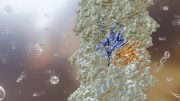

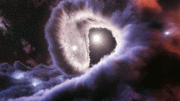
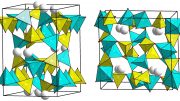
… I don’t understand that resonant frequency thing…
As each planet orbits around the star they each push and pull on their neighbors, resulting in those planets speeding up or slowing down slightly. In turn, their gravity influences their own neighbors (including that first one). Over time, they all settle down to a rhythm where the pushes and pulls due to their gravities are neatly balanced out, and that is the resonance.
Tidal Locking is a similar phenomenon and the Wiki has a nice write-up about it. https://en.wikipedia.org/wiki/Tidal_locking